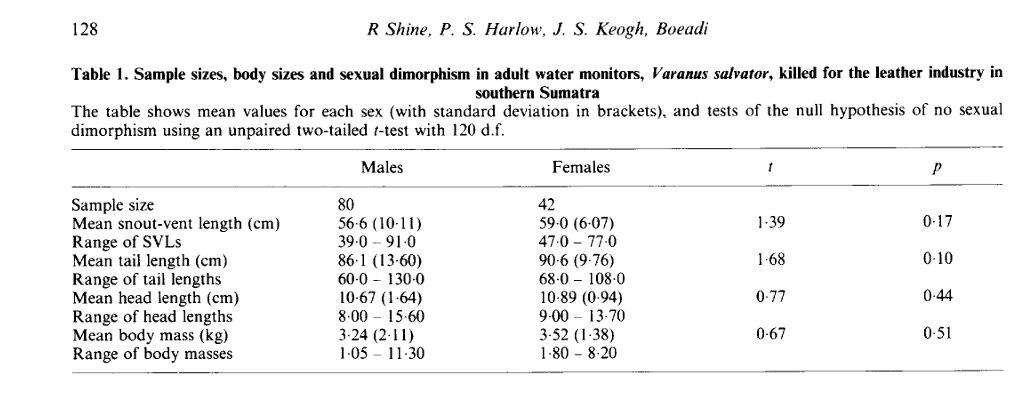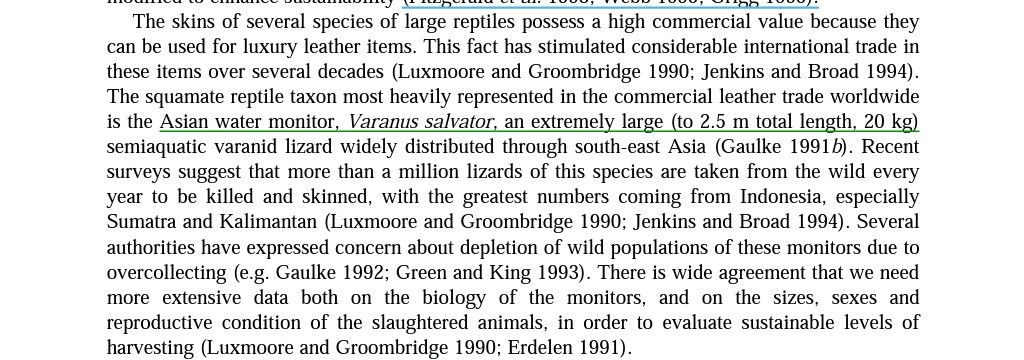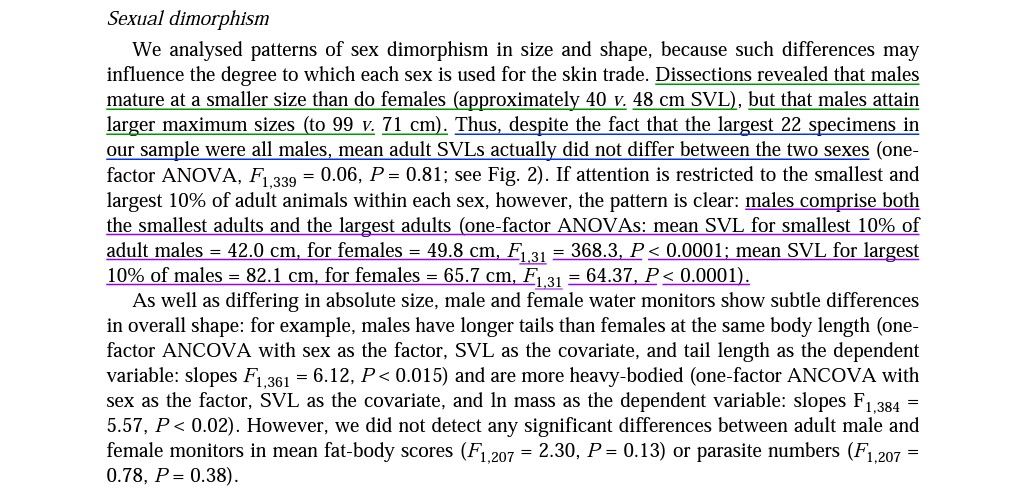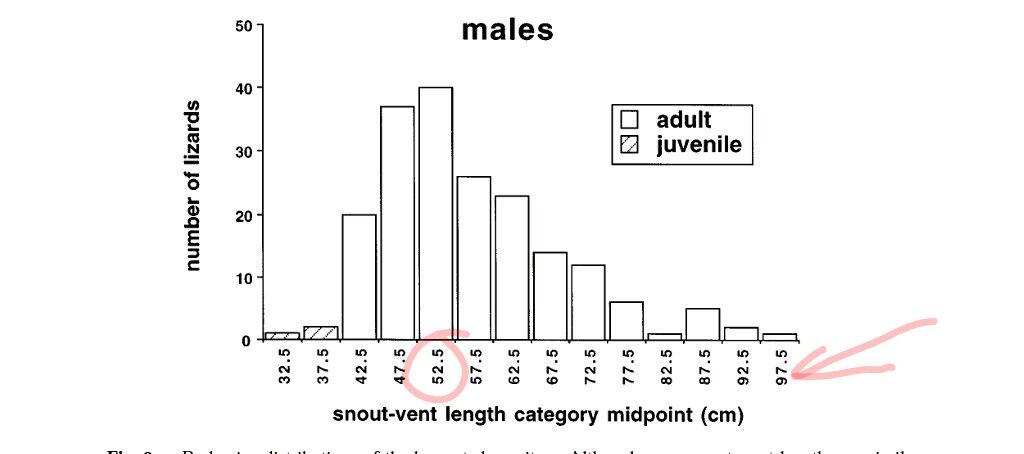Alright folks, prepare yourselves for the ground shaking, mind blowing, top ten scientific facts that throw a complete wrench in the theory of dinosaurs (
link)!!!
And by that I mean the brain cell killing, cancerous cesspool that is dinosaur denialism.
No, it wouldn't. Some organisms would have been better suited to surviving under the harsh conditions brought upon by the K-Pg event than others. Animals that could find shelter from harsh environmental conditions (e.g. crocodilians, mammals, birds) would have been much safer than those that couldn't (e.g. non-avian dinosaurs and pterosaurs). Differing metabolic rates and sizes would have allowed some animals to go longer without sustenance than others. And so on.
What's wrong with evolution "starting over from scratch"? As long as there are still lifeforms alive after an extinction event, starting over is pretty much what happens after a devastating environmental disaster occurs. Therefore, "starting over from scratch" is definitely NOT a concept that throws a big wrench into evolution; in fact, it actually describes what evolution does under a special circumstance (that is, after an extinction event).
What's even funnier is that you believe that for the K-Pg event to wipe out all dinosaurs (bar "deep sea dinosaurs", which never existed and really demonstrates just how much you know about the subject, i.e. little, if anything) it would have to wipe out all other lifeforms as well, yet here you are making a point about how evolution, if true, would then have to start from scratch at that point. How can you expect evolution to start from scratch if there's nothing* left alive?
*I know she mentions "deep sea dinosaurs" (certain non-dinosaurian marine reptiles) as survivors, but given how deep sea communities aren't impervious to environmental changes that can threaten the organisms living in them, I don't feel a need to take these creatures into account.
...What...are you rambling on about? There were no humans back then to get wiped out by the event. The closest things to humans living in that point in time were human ancestors in the form of tiny mammals that had a realistic shot at surviving the K-Pg event. Also, "fallacies that try to argue how dinosaurs and humans existed simultaneously"? You're the one saying that then-nonexistent-humans would have to have been wiped out by the K-Pg event, I don't know why the hell you're bringing up BS notions of non-avian dinosaurs living with humans.
Correction: there would be
paleontological (NOT archaeological; people seriously need to learn the difference between these two sciences) evidence that life was limited in both quantity and diversity and did not see the evolution of significantly different lifeforms, only rebounding until later on. And contrary to that last statement that you probably pulled out of your ass, evidence exists for this. For example, it's been claimed that mammals did not produce descendants over 10-100 kilograms in weight until hundreds of thousands to several million years after the K-Pg event (Alroy, 1998). Lo and behold, more recent research seems to support this. Mammals that survived the K-Pg event tended to weigh ~0.5 kg. It took them 100,000 years to reach 6 kg. It took them 300,000 years to reach 25 kg, as well as evolve the first purely herbivorous mammalian species. And it took them 700,000 years to reach 50 kg (
link->).
NO, IT'S NOT!!! The fundamental mechanics of evolution would not simply cease to operate just because a mass extinction that still fails to kill off about a quarter of all life living just before it happens! That's not how it works at all!
1.) You're naïve if you think the amount of food an animal needs to eat really has such a simple, linear relationship with body mass. While larger animals need to consume absolutely larger amounts of food than smaller animals, they actually need relatively less food for their size than do smaller fauna. That's because the larger an animal is, the less active the mitochondria in its cells are; that is to say, it has a lower metabolism. Of course, some animals have much higher metabolisms than others even at the same body mass (e.g. "ectothermic" non-avian reptiles vs. "endothermic" mammals), so this isn't a perfect relationship, but it's a good rule of thumb, especially when you aren't comparing "ectotherms" to "endotherms". And because non-avian dinosaurs are believed to have been as metabolically active as modern mammals and birds at the most (I mean, animals don't get more "endothermic" than these), it would actually help my case for the viability of giant dinosaurs (like the sauropods) if their metabolisms were indeed relatively less than in mammals or birds (admittedly though, even if they were, I don't think it would be to anywhere near the extent of modern reptiles compared to mammals; but that's okay, it doesn't need to be).
The Etruscan shrew is the smallest mammal alive today by body mass (just 1.8 grams). As is the case with small animals, it has quite a lot of surface area compared to not very much volume. Its mitochondria need to run on overdrive to prevent it from freezing at such a small size; as a result, it has an extreme need for energy. It will starve to death if it goes so much as 4 hours without food.
Large animals, in order to not overheat at their large sizes (the opposite problem from that of small animals), have much less active mitochondria, and therefore don't need to eat as much food for their size. An African elephant may need to eat absolutely far more than an Etruscan shrew, but the elephant needs just 4% of its body mass in food each day to survive. The shrew needs 3x its own body mass in food each day.
While a sauropod would need absolutely more food than an elephant, it would need to eat much less of its body mass in food to survive each day.
2.) Your assertion that even if large sauropods ate at a much quicker rate than modern elephants* and even if they did nothing but eat that they would not reach the climax of their potential size is simply unfounded. I presume this is out of the sheer incredulity you have for the idea of land animals reaching such grand scales.
*Which it seems that they did, seeing as how these animals did not chew, let probably vast digestive chambers extract the maximum amount of nutrition possible, and simply moved on to munch on more vegetation with their long necks giving them access to more food without moving.
Billions of rabbits? The sauropods? Why does it have to be billions of them? Giant sauropods could have been rare relative to much smaller animals wherever they lived given their enormous size. It's as simple as that.
Also, your use of Australia's rabbits as an example is risible. This assumes that the ecosystems giant sauropods lived in could not have had more plants and water available than in Australia. It's just one specific example in the modern world; the Serengeti's rivers for one don't dry up just because there are a whole bunch of zebras and wildebeest in the region. And the reason why is because, unlike Australia's rabbits, zebras and wildebeest are not recently-introduced, invasive species making themselves at home into an ecosystem that they did not originally evolve in (which has obvious adverse consequences).
Oh, and might I add one last thing? Even if giant sauropods were not possible (which they were) that doesn't mean the same holds true for other dinosaurs. As with any clade of animals that makes up such a huge portion of the terrestrial biota of a given time, Dinosauria would mostly have been composed of small animals (e.g. Microraptor). Dinosaurs as heavy as extant elephants would have been plausible as well. Hell, maybe dinosaurs as heavy as the largest terrestrial mammals that ever lived (which too are extinct) could be possible...unless, of course, you doubt these prehistoric mega-mammals (or any fossil mammal for that matter) existed either.
First allow me to ask a question about that image you have under the title of point 8. Did you make it yourself? rolleyes That's just the kind of laughable, accusational drivel I'd expect to hear from an empty-skulled conspiracy nut like you. People do not get disgruntled by other people questioning the theories of evolution and the Big Bang or the former existence of dinosaurs because they want to adhere to beliefs they personally like. They do it because evolution, the Big Bang, and dinosaurs are so well-substantiated that they're not going to have much tolerance for ignoramuses who think they know what they're talking about but are really putting inane, erroneous arguments--some of which may have been refuted countless times before--on the table (like you!). It's no wonder (and completely understandable) why people like you are being dismissed as conspiracy nuts or delusional religious people.
Also, since when have people been coerced to believe in dinosaurs, evolution, and the Big Bang like their lives depend on it? Since when have the threats of losing jobs, ending careers, losing friends, and being ridiculed by family and other people ever existed? Oh wait, that's right,
never!!! Only one of those three things is so widely believed by people that your chances of receiving expressions of disbelief are nearly certain, and that's the idea of the former existence of dinosaurs. Even then, none of the aforementioned threats will actually occur if people learn that you don't believe in dinosaurs, let alone evolution and the Big Bang, the validity of which is seen as much more ambiguous by the general public.
Good thing we can and have supported the view that dinosaurs once existed with evidence. So let me just say that the reason why we act the way we do towards people who question the existence of dinosaurs with nothing more than nonsense (which certainly aren't entirely composed of mere
ad hominem fallacies) is because the existence of dinosaurs should be just as contentious as the fact that 1+1=2, i.e., not at all.
Hmm, I'm not quite sure if there are only a mere thousands of evolutionary biologists, paleontologists, etc.
If by "believing by faith" you mean recognizing that evidence for it that thus far has not been refuted exists, then sure.
The bigger point here though is that this is a lousy crutch of an argument. With the same logic I can say something similar about say, the identity of canker sores (inspired by a real life personal experience): "People don't usually do genuine research on what canker sores are and thus they believe that canker sores are ulcers by faith. Reading claims on the Internet does not count as research".
Which kind of applies to everything else people read in high school and college...not just evolution.
Let's all explain to Veronica over here what a religious belief is:
"
a strong belief in a supernatural power or powers that control human destiny"
www.thefreedictionary.com/religious+belief^That does not describe the theory of evolution.
Yes. And the majority of those believers actually believe in dinosaurs and a substantial amount of them believe in evolution. Therefore, your "lumping" of dinosaurs, evolution, and atheism as if they all necessarily go hand-in-hand is nonsense (and it also shows that your way of looking at them is, frankly, stereotypical).

On a more serious note, the fact that there are some countries around the world (e.g. the United States) where people debate on what (creation or evolution) should or shouldn't be taught goes straight against this (and it's also one thing that helps show that atheists aren't a loud minority).
Nothing could be farther from your 90% figure.
About 99.9% of scientists accept evolution.
This has absolutely no basis whatsoever (also, ^^read above).
It seems to me as if you're pulling things out of thin air, especially with the second statement you made.
What's funny is that Holden (1994) did not argue that giant sauropods did not exist. What's even funnier is that his explanation as to how sauropods were able to be so large is that, guess what...
the gravity was reduced compared to today's (
link)! This suggests that you either saw just that one thing that Holden said and went with it (though to be fair, his suggestion regarding Earth's gravity is indeed ridiculous) or that you decided to pick and choose what to believe from a man with such horrible methods (as I will explain below) in order for your point to hold up.
The bigger picture however is that Holden's conclusions are bollocks. Allow me to show you how he got to this conclusion.
His conclusion is basically that because a scaled up version of human weight lifter Bill Kazmaier with perfect proportions would be unable to stand at over a weight of 20,803 pounds, the same would hold true for sauropods unless gravity is reduced.
Except...anyone with at least an eighth of a brain could immediately see the blatant problem here.
Sauropods. Are Not. Humans.
Because sauropods and humans are not in the least similar in anatomy you cannot expect to learn whether or not one could stand up and operate at a given huge size if another could or couldn't. Surely enough, sauropod anatomy would allow them to exist at such large sizes, regardless whether or not human anatomy would do the same for us (
link).
There's a way you can think of this whole ordeal as well. Let's say that ants had their own equivalent of Ted Holden who tried to calculate if the best weight lifting ants could survive at the size of an elephant. What would his results be? Positive or negative?
Says who? You? If the neck musculature was substantially powerful and if the head connected to it at its anteriormost end was relatively small (as is the case for sauropods), then it could happen. Powerful nuchal ligaments would also allow a sauropod to lift the head and neck up with less muscular effort.
Sauropods would indeed have needed strong hearts (especially if they decided to hold their necks vertically). But what's the problem with that? Your assertions that their hearts would have exploded or that giraffes are at the peak of life-plausible blood pressure are unfounded. I can't tell if you independently thought of this point or heard it from Ted Holden, but at any rate sauropods should have been fine from this issue (
link).
Since this is the last time you single out giant sauropods, allow me to state once again that even if they could not exist does not mean all other, smaller dinosaurs could not. 1 kilogram*
Microraptor would have been fine. 15 kilogram
Velociraptor would have been fine. ~6,000 kilogram
Brontomerus would have been fine...
*Wikipedia gives a citation for a 1 kilogram body weight figure for
Microraptor at a length of 42-83 total body length, but it also gives citations for even larger body lengths (90 and even 120 centimeters TBL).
Well, it seems that those darned schemin' paleontologists are actually doing a pretty good job at not breaking any laws of physics for their "imaginary" creatures to seem plausible.
Firstly, I don't know why you're bringing up pterosaurs here, as they aren't dinosaurs.
Secondly, it's been demonstrated that giant pterosaurs could fly just fine.
markwitton-com.blogspot.com/2013/08/9-things-you-may-not-know-about-giant.htmlthescienceexplorer.com/nature/pterosaurs-should-have-been-too-big-fly-so-how-did-they-manage-itFinally, you fail to realize that even if they were unable to fly that doesn't mean that they couldn't exist at all. Proponents of the notion that large pterosaurs (e.g.
Quetzalcoatlus) couldn't fly did not propose that they did/could not exist, just that they didn't spend their lives flying around.
I've refuted everything you've said above. I need not say anything more to this.
1.) No, we wouldn't. Fossilization is a
very rare process with multiple variables that can prevent it from occurring. First, some environments will be better at preserving fossils than others (e.g. a riverbed would be far better at preserving something than the middle of a desert); this alone will mean that not every single place in the future is going to have fossils, ergo fossils will not be everywhere. Then there are factors such as:
Even after fossilization, the rocks enclosing a fossil will eventually be eroded away by the elements. Unless a paleontologist spots the fossil and removes or in some way protects it, the fossil and the rock surrounding it will continue to be eroded away until they're nothing more than mud or silt. Special environmental events can also negatively affect fossil-bearing rock formations (e.g. one of the reasons why the Eastern Coast of the United States is pretty rare in dinosaur fossils is because the Pleistocene ice age destroyed and relocated dinosaur fossils).
So you have several (all of the aforementioned) variables that come into play before burial, after burial, and even after fossilization going against the preservation of fossils. It's no wonder why we don't find them everywhere.
*This means we won't, and is why we don't, find Mesozoic dinosaur fossils in places like backyards; the surrounding soft mud or silt needs to be compressed down to become rock for fossilization to occur (otherwise what you end up with is something called a subfossil). Maybe if you weren't so ignorant and did your homework on fossilization you'd understand that.
2.) There you go again talking out of your ass. There have been instances where someone accidentally found dinosaur fossils.
mashable.com/2015/04/22/dinosaur-egg-china/#X49tgqriYiqtwww.natureworldnews.com/articles/22581/20160519/amateur-fossil-hunter-accidentally-discovers-new-species-horned-dinosaur-montana.htmlinkThere should certainly be much more accidental fossil finds than just these (especially if you count all other fossil lifeforms).
The limits of carbon dating you've pointed out are true and dandy and all but you fail to realize one simple thing that makes your point here fall so hard (and makes said falling so hilarious).
Radiocarbon dating is not the only method of determining age. There are methods that can be used to reliably date even older materials, materials that can be millions of years old. These are the methods that are used to date dinosaur fossils. 'Nuff said.
It's not anecdotal at all, actually. The first
Megalosaurus remains were uncovered in 1677; it was the distal part of a femur that in 1763 was informally dubbed "
Scrotum humanum". Although the bone is now lost, detailed illustrations of the bone show that it was clearly a bone from a
Megalosaurus. Interestingly, this bone was initially interpreted as belonging to some ancient giant human, showing that there is, in fact, a precedent for mythical creatures (like the ones you mentioned) being inspired by the fossilized bones of ancient animals.
Likewise, archaeologists who accompanied Roy Chapman Andrews to his expedition to Mongolia have found dinosaur eggshells shaped and drilled into jewelry in an archaeological site dating all the way back to at least the early Neolithic, if not late Paleolithic (
source).

Non-avian dinosaurs aren't the only fossil lifeforms to have their remains uncovered before the 19th century, either. The first mosasaur remains were discovered in 1764 (skull bones at a hill near Maastricht, the Netherlands). A mammoth tusk found in the 16th century near the Bühler was interpreted as a unicorn horn and placed in the choir aisle of St. Michael, where it remains to this day. Ancient elephant bones were discovered near a flint hand axe in London in 1679 (
link->). In 1443, a mammoth femur was uncovered during the construction of St. Stephen's Cathedral; it was inscribed on and interpreted as the bone of a giant killed in the Great Flood. We've found fossils found in pre-Columbian Native American sites, such as bead necklaces made out of crinoid and coral fossils, projectile points made from petrified wood (there are thousands of petrified wood specimens modified by pre-Columbian Americans), and carved brachiopod fossils.

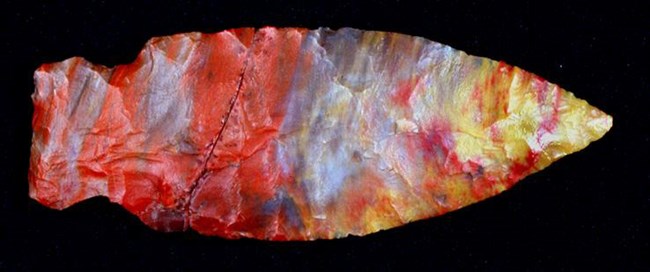
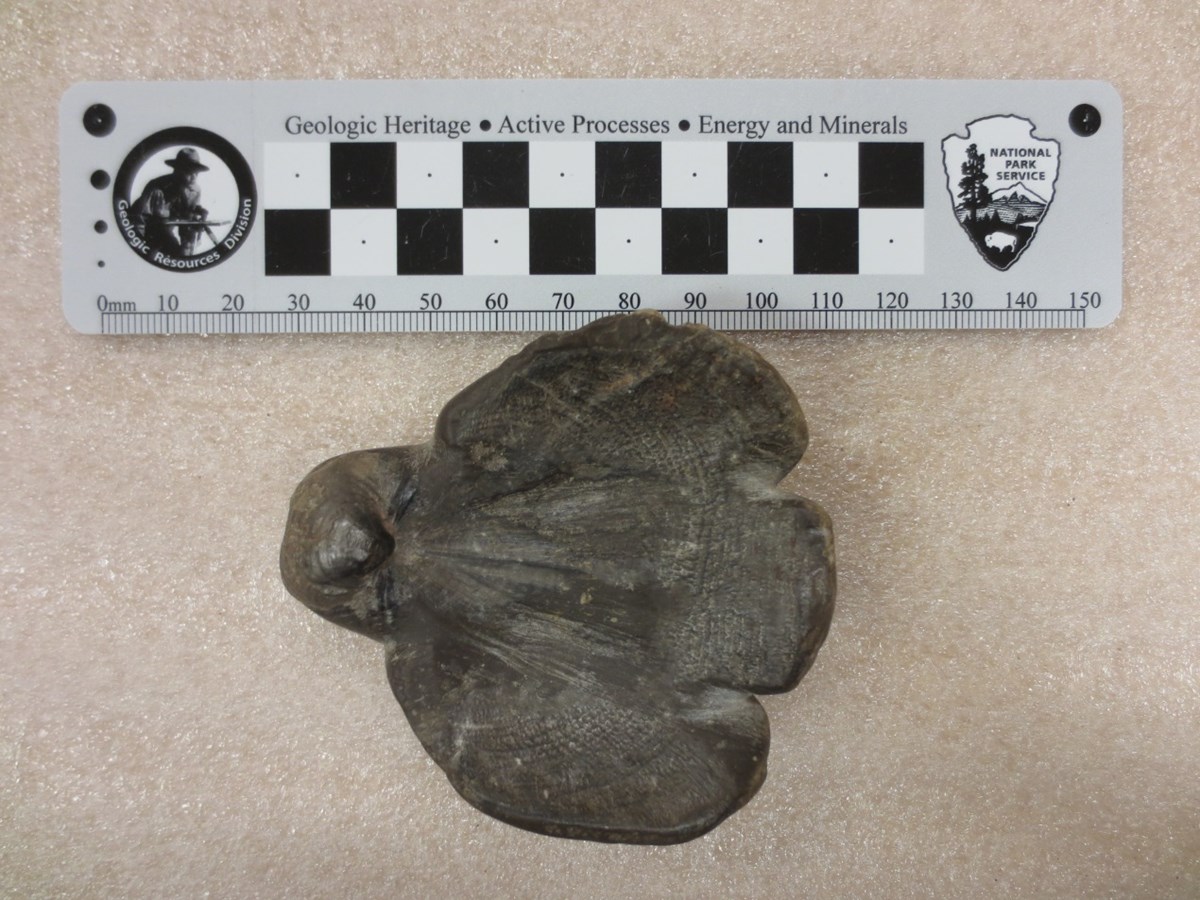 Image source->
Image source->Hell, people in the late 15th to early 16th centuries knew that there were fossil mollusk shells on the tops of mountains. Most didn't know (or believe) that they once belonged to living creatures. Way more strikingly, Leonardo da Vinci was able to recognize the fact that they were, based on the visible growth rings. He was able to recognize that they weren't there due to a global flood, grasped the law of superposition, and all that (
link).
But sure, let's just ignore these facts. Pretend that fossils, including those of dinosaurs, were never found prior to the 19th century. Because, you know, denying facts actually strengthens your argument! /sarcasm off
Ironically, your denial of this fact exposes an enormous hole in your argument.
If dinosaur fossils were never uncovered prior to the 19th century (which they were), how can you ever expect dinosaurs that have been dead for at least 66 million years to ever be incorporated into mythology???!!! The simple answer is, you can't! The only way the concept of dinosaurs could have made its way into mythologies around the world before the nineteenth century is if people had
actually discovered their remains and on top of that interpreted them correctly. In other words,
people would actually have to know what a dinosaur is to incorporate dinosaurs into mythology (mind-blowing logic, innit?). You don't seem to be so convinced that the former ever happened, though, meaning your point makes no sense.
Also, I don't know if this ever occurred to you, but all previously-unknown discoveries have to be made at some point. Why should the fact that the concept of dinosaurs (i.e. a true understanding of the basic idea of what their fossils really showed evidence of) only came about during the nineteenth century as a result of discovery and examination really garner any more suspicion and investigation than the fact that say, the concept of bacteria only came about during the seventeenth century as a result of the same two aforementioned concepts?
Now, to get a bit beside the main point here. We've established that the only way for dinosaurs to be incorporated into mythologies prior to the 1800s would be for people to actually discover their fossils and interpret them for what they really were. If this happened, it's very likely that dinosaurs would be incorporated into mythology; they've produced forms that people would have seen as awe-inspiring, impressive, and fascinating (hell, people today do). But "the focal point of all of historical mythology"? For all their magnificence, dinosaurs were, after all, just animals. Would they really be any more compelling than lions (big, fast, pack hunting predators)? Or elephants (the biggest land animals today with weird-looking faces)? Or whales (the only animals that surpassed any dinosaur in size)?
Citation please, no fabricated claims.
These are the only things of the three you mentioned that may actually be used in dinosaur mounts, and there are good reasons for this. Heinrich Mallison sums up the reasons for using casts in museum mounts quite well:
linkOnce again, you are making up "facts" to support your argument. Unfortunately, I can't link every single dinosaur discovery to you as you'd simply state that they're all hoaxes with absolutely no basis for your assertions.
Since the title of this point is "A full skeleton or a dinosaur has never been found - not even close to one", I'm guessing this part ties into the main premise here. Anyway, how much we find of a dinosaur (or likely any fossil organism for that matter; certainly every animal with an internal skeleton) varies with each instance. Not every time do we have to guess with just 1% of the actual animal left. For example,
Tyrannosaurus rex specimen FMNH PR 2081 ("Sue") is apparently over 90% complete.
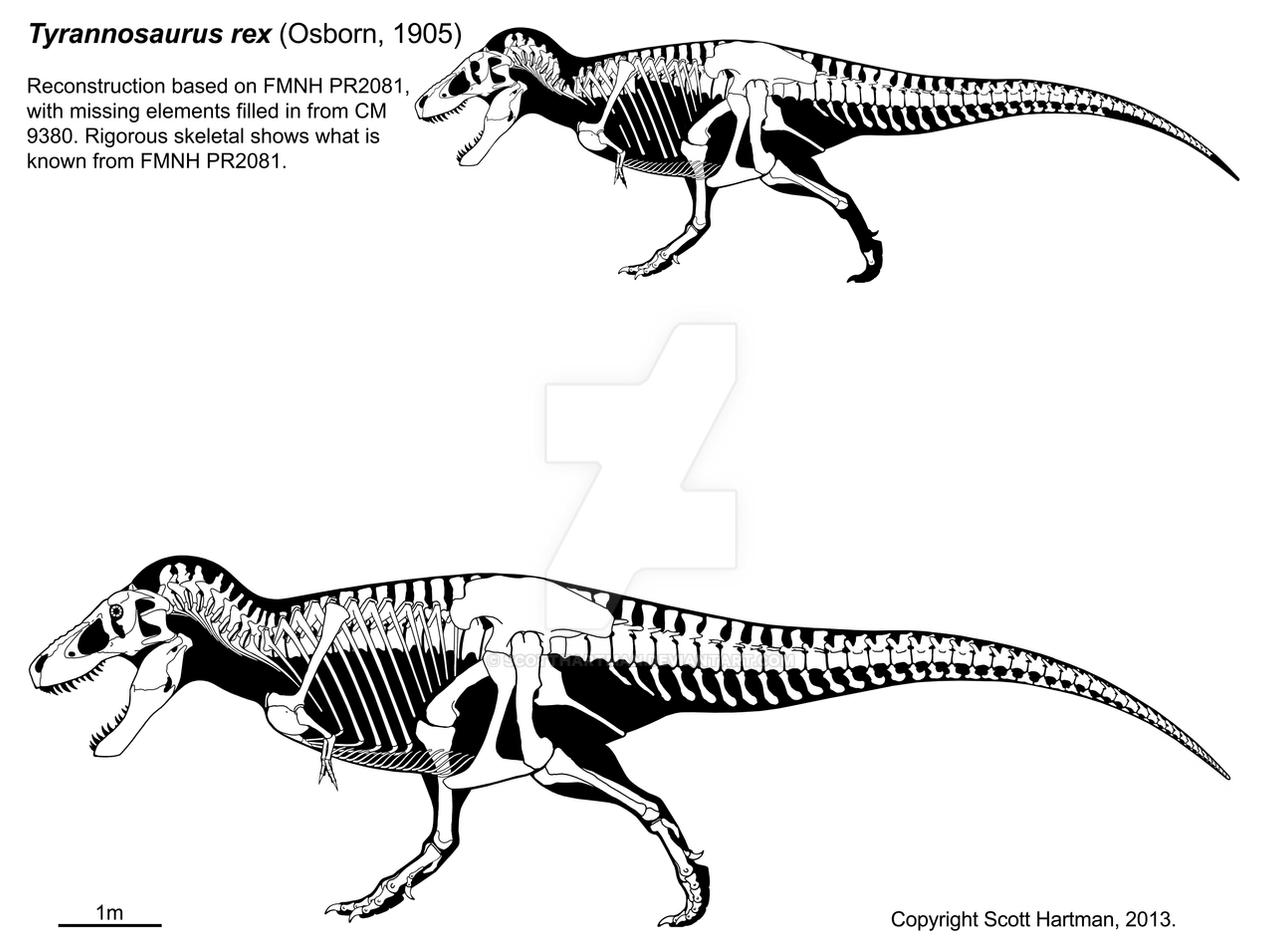
^The smaller silhouette on top shows how much we have from the specimen. As you can see, that's a lot, and therefore allows us to make very reasonable inferences on what the rest of the skeleton looked like.
Of course, not all dinosaur specimens are this complete. Take for example, the recently-discovered
Gualicho shinyae.

As you can see, this specimen is substantially incomplete. So how exactly do we know what the rest of the skeleton looked like if we don't have it? Well, what we can do is use what remains we have to try and determine its affinities, and sometimes we actually get answers.
"
Derived characters of the scapula, femur, and fibula supports the new theropod as the sister taxon of the nearly coeval African theropod Deltadromeus
and as a neovenatorid carcharodontosaurian."
linkThis allows us to make reasonable inferences on what the rest of the skeleton looked like.
For dinosaurs that we cannot conclusively determine the specific affinities of and/or are just too fragmentary, then we can only speculate on what they looked like; they are not stated to have absolutely looked one way until better remains are discovered.
Might I add however, that it's not impossible to infer what an animal looked like based on scant remains. Case in point, in 1804, paleontologist and anatomist Georges Cuvier was able to identify a fossil as that of an opossum, based only on teeth (
link).
That's just another unfounded claim made by you in order to support your argument.
^^Read above.
No I wouldn't, neither would (or at least should) anyone else, and nor would a science book ever claim the two examples of a bullfaeces claim you've provided. Not considering how the existence of dragons is completely unsubstantiated and hence the farthest thing from established.
It utterly amuses me how you're on about presupposition and how the scientific method works and at the same time are still talking out of your ass for the sake of your argument.
That dinosaurs were presupposed could not be any farther from the truth. The term 'dinosaur' was not coined until 1842, 18 years after the first non-avian dinosaur (Megalosaurus) was named.
First of all, there were no "deep ocean dinosaurs" (once again showing how little you know on the matter). What you're thinking of are marine reptiles such as plesiosaurs, mosasaurs, and ichthyosaurs (the last of which became extinct before the dinosaurs did), and the closest thing these animals had in common with dinosaurs is their reptilian descent.
As for your belief that these animals should have survived: it's not like the deep ocean (whether you mean really deep depths thereof or just any part of the ocean that is deep) is some invincible ecosystem that would be completely unscathed by an extinction event. One thing that may have negatively affected deep ocean biota would be the inability for photosynthesis to occur due to the accumulation of dust in the atmosphere (a result the huge impact of the Chicxulub asteroid). This would have led to a collapse in the food chain, similar to what would have been happening to the dinosaurs et al. on land.
There is no "overwhelming scientific evidence" that suggests dinosaurs didn't exist. There is however, evidence of vice versa, evidence that you seem to deny on no legitimate grounds other than "I want to believe it".
Only in your deluded little world.
Because we all know that whether or not we humans incorporated something into *mythology* is an indicator of how likely said thing existed. *facepalm.








